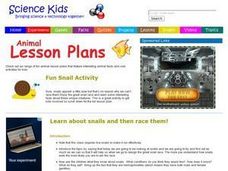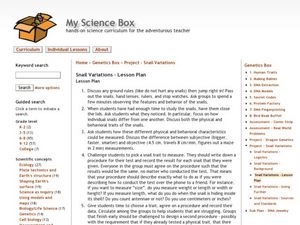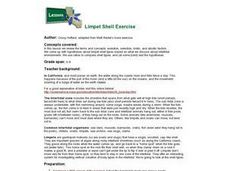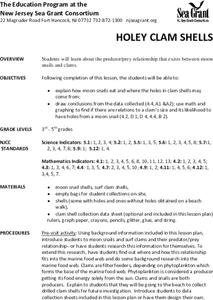Curated OER
Trace the Snail
In this tracing worksheet, learners trace a picture of a snail with the color yellow, then color the snail's shell yellow, and the snail's body green.
Curated OER
Parts of a Snail
Here is a simple, yet well-designed worksheet on the parts of a snail for your young biologists. Learners label the five parts of a snail using words that appear on the worksheet. Then, they circle the words on the bottom of the...
Curated OER
My Science Box: Snail Variation
Young scholars observe snails and their characteristics. In this science lesson, students decide how to measure their snails and to observe a behavioral trait. Young scholars create a graph to present their findings.
Curated OER
What Lives In A Shell?
Younger students focus on animals and animal habitats in the lower grades. This resource defining habitats focuses on sea animals with shells, but could be augmented to be a richer experience.
Curated OER
Slugs and Snails
Slugs and snails are the focus of this life science worksheet. Student read a selection on these animals, then answer ten comprehension questions. Then, students must draw an "alien portrait" using the characteristics of slugs and snails...
Curated OER
Learn about snails and then race them!
Students examine snails and make observations about where their eyes are located, how they eat, and how they move. In this snails lesson, students discover information about snails by observing them. Students use magnifying glass, a...
DK Publishing
Mary Sorted Her Snails
Mary needs help sorting her snails! Each snail has one of three distinct patterns on its shell, and scholars sort each into the proper category. Then, they count the number of snails in each pattern group (triangles, circles, and zigzag)...
Curated OER
Moon Snails
In this moon snails learning exercise, learners read a 2 page article on moon snails, define 8 vocabulary words relating to moon snails and answer 7 short answer questions relating to the article.
Curated OER
Bivalve or Univalve (Clam or Snail)?
Fourth graders explore the meaning of the prefixes "bi" and "uni." In groups, 4th graders observe pictures of shells and handle real shells. Students create a chart to classify each shell as a bivalve or univalve. They identify the...
Curated OER
Trace and Color the Snail: Yellow and Green
In this activity on coloring and tracing, learners follow directions and trace and color the snail's shell yellow, then color the snail green.
Curated OER
Snails
First graders investigate the organism known as a snail. They use snails to make observations of the body structure and the basic needs. The class is shown a chart and the teacher uses questions to induce student thinking. Then they...
Biology Junction
Mollusks
Mollusks created every shell on Earth. Young scientists learn more about the phyllum mollusca in an informative presentation. It covers their characteristics, body plans, and relationships in the ecosystem. Then, it details each class of...
Curated OER
My Science Box
Students investigate snails and their physical and behavioral characteristics. In this investigative lesson plan students create a pie chart to show the results of their findings.
Curated OER
The Search for Housing Pagurus hirsutiusculus= hermit crab
Students collect snail shells, measure and record their lengths and if they are occupied by a hermit crab. They discover if their is a size difference between occupied and unoccupied shells.
Curated OER
Limpet Shell Exercise
Students review the terms and concepts: evolution, selection, biotic, and abiotic factors. They come up with hypotheses about limpet shell types based on what we discuss about intertidal environments. Students use ratios to compare...
Curated OER
Oddball Out: Shells
In this problem solving worksheet, young scholars analyze a row of pictures of various shells to determine which creature is different from the others pictured.
Curated OER
Mollusk Matching
Students look carefully at shells and observe the differences between
species and the names of common shells. Then they identify and complete a Mollusk Matching handout included in the lesson plan and write the letter of each shell in...
Poetry Society
A Conceit Poem
Young writers needn't be self-involved to craft a conceit. Directions for how to craft this form of extended metaphor, models, and a worksheet are all included in the packet.
Curated OER
Discussing Poetry In Class
Students investigate syllabic metre and rhyming techniques by analyzing poetry. In this language arts lesson plan, students read the poem Considering the Snail and discuss the nature and mood of the poem with their classmates. Students...
Curated OER
Holey Clamshells
Students analyze data to make hypotheses and conclusions regarding the predator/prey relationship between moon snail and surf clams.
Curated OER
CSI Clamshell Investigation
Pupils explore and explain how moon snails eat and where the holes in clamshells come from and then draw conclusion from the data collected. They incorporate math and graphing skills to determine if there is a relationship to a clam's...
Curated OER
Create a Display
Students identify mollusks, create a display, research a particular species, and present their findings to the class. They collect and bring in a shell of choice from their local beach. Then, students label his or her shell with the...
Curated OER
Comparing and Contrasting
Learners practice compare and contrast skills. In this science and language development lesson, students complete a T chart generating traits of a snail and a clam. Learners complete a related worksheet.
Curated OER
Marine Habitats of Galveston Island
Four lessons introduce elementary ecologists to salt marsh and sandy beach habitats. In the first instructional activity, they place shells and other materials in vinegar to determine if they contain calcium carbonate. In the second...

























